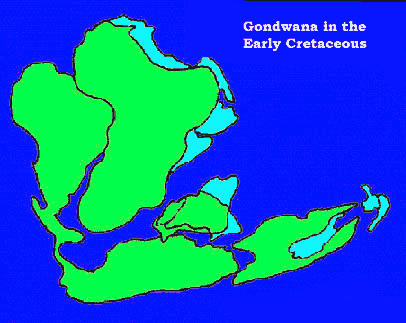Africa
 Africa was assembled from smaller cratons along the (probably) western and southern margins of the Proterozoic equatorial supercontinent of Rodinia. After the break-up of Rodinia, the African cratons drifted south and fused in roughly their present arrangement by the Neoproterozoic. At that time, Africa lay in a north-south orientation (i.e., in generally the same orientation as it has today), with its southern end at to near the south pole. This understanding is somewhat controversial, and is discussed at Cryogenian.
Africa was assembled from smaller cratons along the (probably) western and southern margins of the Proterozoic equatorial supercontinent of Rodinia. After the break-up of Rodinia, the African cratons drifted south and fused in roughly their present arrangement by the Neoproterozoic. At that time, Africa lay in a north-south orientation (i.e., in generally the same orientation as it has today), with its southern end at to near the south pole. This understanding is somewhat controversial, and is discussed at Cryogenian.
In this position, it became the core of Gondwana, bounded by South America and West Antarctica on the west, and India and East Antarctica on the east. The entire assembly underwent some internal rotation and drifted generally northward, where it collided with Euramerica in the Carboniferous to form the world-continent of Pangaea. Africa began to rift free of North America in the Rhaetian (Late Triassic), beginning the proto-Atlantic and the breakup of Pangea. During the Tithonian terminal Jurassic) India broke free and drifted north. The Cretaceous saw African Gondwanaland as several large islands separated by shallow continental seas, and populated by a unique fauna of dinosaurs Spinosaurus, Rebbachisaurus, Ouranosaurus, Carcharodontosaurus, etc). Rifting from South America began during the Valanginian, widening to an ocean by the Santonian Late Cretaceous), while to the south-east, it separated from Antarctica.
The Paleogene saw a radiation of endemic mammals on the isolated continent - the Proboscidians (elephants), Hyracoids, and the rhino-like Arsinoitheres. Arabia, which had been a part of Africa, began separating in the late Oligocene, a process which continues today. In the early Miocene, Arabia contacted Eurasia. The resulting connection enabled the Proboscidea to migrate to other continents, while other mammals immigrated into Africa. The Anthropoid apes were part of this migration, but it is uncertain which direction they traveled. It has often been written that the anthropoids originated in Africa, but recent work places their birth to the Eocene of Asia.
The Pliocene witnessed the rise and radiation of a number of successive hominid lines (Ardipithecus, Australopithecus, Parapithecus, Homo habilis and Homo erectus), the widening Red Sea forming oceanic crust for the first time, and a dramatic decrease in rainfall in East Africa, a direct result of glaciation in higher latitudes of the globe.
page uploaded to Keeper site 22 April 1999, uploaded to Palaeos
6 April 2002
modified ATW060909
checked ATW021001, edited RFVS111106
unless otherwise specified, content ©
M Alan Kazlev 1999-2002
bars and buttons from Jeanne's families of graphics
this material may be freely used for non-commercial purposes
 Africa was assembled from smaller cratons along the (probably) western and southern margins of the Proterozoic equatorial supercontinent of Rodinia. After the break-up of Rodinia, the African cratons drifted south and fused in roughly their present arrangement by the Neoproterozoic. At that time, Africa lay in a north-south orientation (i.e., in generally the same orientation as it has today), with its southern end at to near the south pole. This understanding is somewhat controversial, and is discussed at Cryogenian.
Africa was assembled from smaller cratons along the (probably) western and southern margins of the Proterozoic equatorial supercontinent of Rodinia. After the break-up of Rodinia, the African cratons drifted south and fused in roughly their present arrangement by the Neoproterozoic. At that time, Africa lay in a north-south orientation (i.e., in generally the same orientation as it has today), with its southern end at to near the south pole. This understanding is somewhat controversial, and is discussed at Cryogenian.